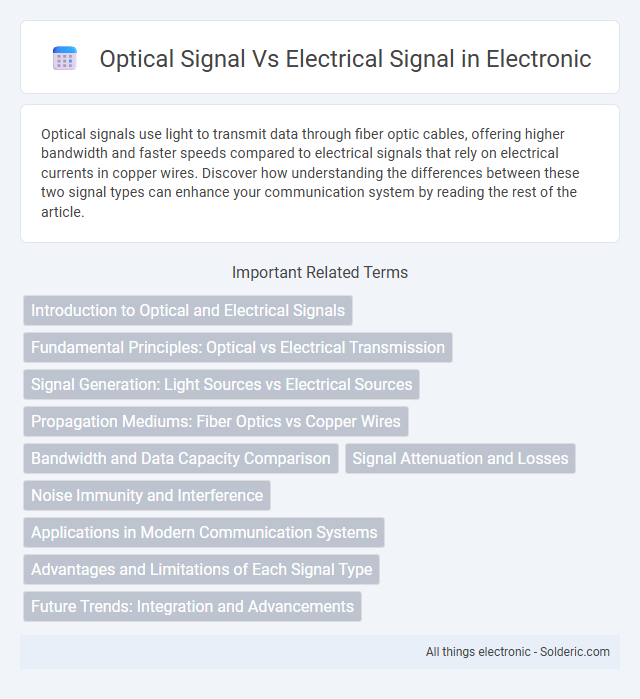Optical signals use light to transmit data through fiber optic cables, offering higher bandwidth and faster speeds compared to electrical signals that rely on electrical currents in copper wires. Discover how understanding the differences between these two signal types can enhance your communication system by reading the rest of the article.
Comparison Table
| Feature | Optical Signal | Electrical Signal |
|---|---|---|
| Medium | Fiber optic cables (light transmission) | Copper wires or metal conductors |
| Signal Type | Light pulses (photons) | Electric voltage/current (electrons) |
| Bandwidth | High (Tbps scale) | Lower (Mbps to Gbps range) |
| Signal Attenuation | Low over long distances | High over long distances |
| Interference | Immune to electromagnetic interference (EMI) | Susceptible to EMI and crosstalk |
| Security | Harder to tap without detection | Easier to intercept and tap |
| Signal Loss | Minimal; requires optical amplifiers | Significant; requires repeaters and amplifiers |
| Latency | Lower latency in data transmission | Higher latency compared to optical |
| Cost | Higher initial installation cost | Lower installation cost |
| Use Cases | High-speed internet, long-distance telecom, data centers | Local area networks, electrical devices, short-range communication |
Introduction to Optical and Electrical Signals
Optical signals use light waves transmitted through fiber optic cables, providing high-speed data transfer with low attenuation and electromagnetic interference. Electrical signals rely on voltage or current variations within copper wires, commonly used in traditional communication networks but more susceptible to signal degradation over long distances. Optical technology supports higher bandwidth and longer transmission ranges compared to electrical signaling in modern telecommunication infrastructures.
Fundamental Principles: Optical vs Electrical Transmission
Optical signals rely on light waves transmitted through fiber optic cables, enabling high-speed data transfer with minimal loss and electromagnetic interference compared to electrical signals, which use voltage pulses along copper wires. The fundamental principle behind optical transmission involves converting electrical signals into light, leveraging total internal reflection for efficient data propagation over long distances. Understanding these differences helps optimize Your network design by choosing the appropriate medium based on speed, distance, and environmental factors.
Signal Generation: Light Sources vs Electrical Sources
Optical signal generation relies on light sources such as lasers and light-emitting diodes (LEDs), which produce coherent or incoherent light respectively, enabling high-speed data transmission with minimal loss over long distances. Electrical signals, generated by voltage or current sources like transistors and oscillators, depend on electron flow through conductive materials, often facing limitations in bandwidth and susceptibility to electromagnetic interference. Understanding the distinction between your optical light sources and traditional electrical signal generators is crucial for optimizing communication system performance.
Propagation Mediums: Fiber Optics vs Copper Wires
Optical signals propagate through fiber optics using light pulses, enabling high-speed data transmission with minimal signal loss and immunity to electromagnetic interference. Electrical signals travel through copper wires by electron flow, which is prone to attenuation, signal degradation, and susceptibility to electromagnetic noise over long distances. Fiber optic cables support greater bandwidth and longer transmission ranges compared to copper wires, making them ideal for modern telecommunications and high-speed internet applications.
Bandwidth and Data Capacity Comparison
Optical signals utilize light waves, offering significantly higher bandwidth and data capacity compared to electrical signals transmitted through copper cables. Fiber optic communication supports bandwidths reaching terabits per second (Tbps), far exceeding the gigabit per second (Gbps) limits typical of electrical signaling in twisted-pair or coaxial cables. This vast bandwidth advantage enables optical signals to handle exponentially larger data volumes with minimal signal degradation over long distances, essential for modern high-speed networks.
Signal Attenuation and Losses
Optical signals experience significantly lower attenuation compared to electrical signals, enabling long-distance data transmission with minimal signal loss. Factors such as absorption, scattering, and bending losses primarily affect optical signals, while electrical signals face resistance, capacitive, and inductive losses within conductive materials. Understanding these differences helps you optimize communication systems by selecting the appropriate signal type for reduced attenuation and improved performance.
Noise Immunity and Interference
Optical signals exhibit superior noise immunity compared to electrical signals due to their resistance to electromagnetic interference, which makes them ideal for high-speed data transmission in environments with high electrical noise. Electrical signals are prone to signal degradation and crosstalk caused by external electromagnetic fields, reducing transmission quality over long distances. Your communication system benefits from optical signaling when minimizing data loss and maintaining signal integrity in electrically noisy environments.
Applications in Modern Communication Systems
Optical signals are predominantly used in high-speed fiber optic communication networks, enabling long-distance data transmission with minimal signal loss and electromagnetic interference. Electrical signals remain essential in traditional copper-based systems and local area networks, supporting shorter distance connections and compatibility with existing infrastructure. Your choice between optical and electrical signals impacts bandwidth capacity, transmission speed, and overall system performance in modern communication applications.
Advantages and Limitations of Each Signal Type
Optical signals offer high bandwidth, low attenuation, and immunity to electromagnetic interference, making them ideal for long-distance and high-speed data transmission, whereas their main limitations include higher installation costs and sensitivity to physical damage. Electrical signals are cost-effective and compatible with most existing infrastructure, providing ease of signal processing, but they suffer from signal degradation, limited bandwidth, and susceptibility to electromagnetic interference. Choosing between optical and electrical signals depends on application requirements such as distance, data rate, environmental conditions, and cost constraints.
Future Trends: Integration and Advancements
Future trends in optical signal and electrical signal technology highlight rapid advancements in integration, with photonic-electronic hybrid chips enhancing data transmission speeds and energy efficiency. You can expect breakthroughs in silicon photonics to enable seamless integration of optical components with existing electrical circuits, driving innovation in telecommunications and computing. These advancements promise to revolutionize the architecture of networks by reducing latency and increasing bandwidth capacity.
Optical signal vs electrical signal Infographic

 solderic.com
solderic.com